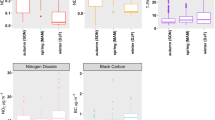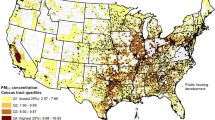Abstract
Safe school environments are essential for healthy development, yet some schools are near large-scale livestock facilities that emit air pollution. Hydrogen sulfide (H2S) from decomposing manure is an indicator of livestock-related air pollution. We measured outdoor concentrations of H2S at three public middle schools near livestock facilities in North Carolina. We used circular graphs to relate H2S detection and wind direction to geospatial distributions of nearby livestock barns. We also used logistic and linear regression to model H2S in relation to upwind, distance-weighted livestock barn area. Circular graphs suggested an association between upwind livestock barns and H2S detection. The log-odds of H2S detection per 1000 m2 increased with upwind weighted swine barn area (School A: β-coefficient (β)=0.43, SE=0.06; School B: β=0.64, SE=0.24) and upwind weighted poultry barn area (School A: β=0.05, SE=0.01), with stronger associations during periods of atmospheric stability than atmospheric instability (School A stable: β=0.69, SE=0.11; School A unstable: β=0.32, SE=0.09). H2S concentration also increased linearly with upwind swine barn area, with greater increases during stable atmospheric conditions (stable: β=0.16 parts per billion (p.p.b.), SE=0.01; unstable: β=0.05 p.p.b., SE=0.01). Off-site migration of pollutants from industrial livestock operations can decrease air quality at nearby schools.
This is a preview of subscription content, access via your institution
Access options
Subscribe to this journal
Receive 6 print issues and online access
$259.00 per year
only $43.17 per issue
Buy this article
- Purchase on Springer Link
- Instant access to full article PDF
Prices may be subject to local taxes which are calculated during checkout



Similar content being viewed by others
References
Paulson J, Barnett C . Who's in charge of children's environmental health at school? New Solut 2010; 20 (1): 3–23.
Scammell MK, Levenstein C . School health and environment. New Solut 2010; 20 (1): 1–2.
Sampson N . Environmental justice at school: understanding research, policy, and practice to improve our children's health. J Sch Health 2012; 82 (5): 246–252.
United States Department of Agriculture. 2012 Census of Agriculture: North Carolina State and County Data. 2014; AC-12-A-51.
Hog density by county. Feedstuffs. 2010. Accessed 5 May 2015. Available at http://fdsmagissues.feedstuffs.com/fds/PastIssues/FDS8221/fds14_8221.pdf. and http://fdsmagissues.feedstuffs.com/fds/PastIssues/FDS8221/fds15_8221.pdf.
von Mutius E . 99th Dahlem conference on infection, inflammation and chronic inflammatory disorders: farm lifestyles and the hygiene hypothesis. Clin Exp Immunol 2010; 160 (1): 130–135.
Fuchs O, Genuneit J, Latzin P, Buchele G, Horak E, Loss G et al. Farming environments and childhood atopy, wheeze, lung function, and exhaled nitric oxide. J Allergy Clin Immunol 2012; 130 (2): 382–388.
Merchant JA, Naleway AL, Svendsen ER, Kelly KM, Burmeister LF, Stromquist AM et al. Asthma and farm exposures in a cohort of rural Iowa children. Environ Health Perspect 2005; 113 (3): 350–356.
Pavilonis BT, Sanderson WT, Merchant JA . Relative exposure to swine animal feeding operations and childhood asthma prevalence in an agricultural cohort. Environ Res 2013; 122: 74–80.
Mirabelli MC, Wing S, Marshall SW, Wilcosky TC . Asthma symptoms among adolescents who attend public schools that are located near confined swine feeding operations. Pediatrics 2006; 118 (1): e66–e75.
Sigurdarson ST, Kline JN . School proximity to concentrated animal feeding operations and prevalence of asthma in students. Chest 2006; 129 (6): 1486–1491.
Mirabelli MC, Wing S, Marshall SW, Wilcosky TC . Race, poverty, and potential exposure of middle-school students to air emissions from confined swine feeding operations. Environ Health Perspect 2006; 114 (4): 591–596.
Iowa State University and the University of Iowa Study Group. Iowa Concentrated Animal Feeding Operations Air Quality Study. 2002. Accessed 17 May 2006. Available at http://www.public-health.uiowa.edu/ehsrc/cafostudy.htm.
National Research Council (NRC) Air Emissions from Animal Feeding Operations: Current Knowledge, Future Needs. National Academies Press: Washington, DC. 2003.
Schiffman SS, Bennett JL, Raymer JH . Quantification of odors and odorants from swine operations in North Carolina. Agric For Meteorol 2001; 108 (3): 213–240.
Aneja VP, Blunden J, James K, Schlesinger WH, Knighton R, Gilliam W et al. Ammonia assessment from agriculture: U.S. status and needs. J Environ Qual 2008; 37 (2): 515–520.
Cole D, Todd L, Wing S . Concentrated swine feeding operations and public health: a review of occupational and community health effects. Environ Health Perspect 2000; 108 (8): 685–699.
Guidry VT, Lowman A, Hall D, Baron D, Wing S . Challenges and benefits of conducting environmental justice research in a school setting. New Solut 2014; 24 (2): 153–170.
Wang XR, Pan LD, Zhang HX, Sun BX, Dai HL, Christiani DC . Follow-up study of respiratory health of newly-hired female cotton textile workers. Am J Ind Med 2002; 41 (2): 111–118.
Glass DC, Gray CN . Estimating mean exposures from censored data: exposure to benzene in the Australian petroleum industry. Ann Occup Hyg 2001; 45 (4): 275–282.
Helsel D . Much ado about next to nothing: incorporating nondetects in science. Ann Occup Hyg 2010; 54 (3): 257–262.
Hornung RW, Reed LD . Estimation of average concentration in the presence of nondetectable values. Appl Occup Environ Hyg 1990; 5 (1): 46–51.
U.S. Environmental Protection Agency (EPA). Meteorological Monitoring Guidance for Regulatory Modeling Applications. 2000; EPA-454/R-99-005.
NC OneMap. North Carolina Orthoimagery Program. 2013. Accessed 1 October 2013. Available at http://www.nconemap.com/OrthoimageryforNorthCarolina.aspx.
NC OneMap GeoSpatial Portal. 2010 North Carolina Statewide Digital Orthoimagery- Download. 2015; Available at http://data.nconemap.com/geoportal/catalog/search/resource/details.page?uuid={89BC136A-D247-4E7A-AB52-794CABED3F7E}.
North Carolina Center for Geographic Information and Analysis. North Carolina Statewide Orthoimagery 2010 Final Report. Durham, NC, 2011. Available at http://www.nconemap.com/Portals/7/documents/StatewideOrthoimagery2010_FinalReport.pdf.
Environmental Systems Research Institute (ESRI). ArcGIS Help 10.1—Mosaic dataset properties. 2013. Available at http://resources.arcgis.com/en/help/main/10.1/index.html#//009t00000038000000.
O'Shaughnessy PT, Altmaier R . Use of AERMOD to determine a hydrogen sulfide emission factor for swine operations by inverse modeling. Atmos Environ 2011; 45 (27): 4617–4625.
United States Environmental Protection Agency. Poultry production. 2012. Accessed 5 March 2015. Available at http://www.epa.gov.libproxy.lib.unc.edu/agriculture/ag101/printpoultry.html.
Lemon J . Plotrix: a package in the red light district of R. R-News 2006; 6 (4): 8–12.
Carslaw D, Ropkins K 2015 openair: open-source tools for the analysis of air pollution data. R package version 1.5. Available at http://CRAN.R-project.org/package=openair.
Greenland S . Randomization, statistics, and causal inference. Epidemiology 1990; 1 (6): 421–429.
Rothman KJ . Statistics in nonrandomized studies. Epidemiology 1990; 1 (6): 417–418.
Wing S, Horton RA, Marshall SW, Thu K, Tajik M, Schinasi L et al. Air pollution and odor in communities near industrial swine operations. Environ Health Perspect 2008; 116 (10): 1362–1368.
Schwartz J . Air pollution and children's health. Pediatrics 2004; 113 (4 Suppl): 1037–1043.
Agency for Toxic Substances and Disease Registry (ATSDR). Toxicological profile for Hydrogen Sulfide/Carbonyl Sulfide (Draft for Public Comment) 2014.
Schinasi L, Horton RA, Guidry VT, Wing S, Marshall SW, Morland KB . Air pollution, lung function, and physical symptoms in communities near concentrated Swine feeding operations. Epidemiology 2011; 22 (2): 208–215.
Schiffman SS, Studwell CE, Landerman LR, Berman K, Sundy JS . Symptomatic effects of exposure to diluted air sampled from a swine confinement atmosphere on healthy human subjects. Environ Health Perspect 2005; 113 (5): 567–576.
Horton RA, Wing S, Marshall SW, Brownley KA . Malodor as a trigger of stress and negative mood in neighbors of industrial hog operations. Am J Public Health 2009; 99 (Suppl 3): S610–S615.
Wing S, Horton RA, Rose KM . Air pollution from industrial swine operations and blood pressure of neighboring residents. Environ Health Perspect 2013; 121 (1): 92–96.
Smit LA, Hooiveld M, van der Sman-de Beer F, Opstal-van Winden AW, Beekhuizen J, Wouters IM et al. Air pollution from livestock farms, and asthma, allergic rhinitis and COPD among neighbouring residents. Occup Environ Med 2014; 71 (2): 134–140.
Borlee F, Yzermans CJ, van Dijk CE, Heederik D, Smit LA . Increased respiratory symptoms in COPD patients living in the vicinity of livestock farms. Eur Respir J 2015; 46 (6): 1605–1614.
U.S. Environmental Protection Agency (EPA). Air trends: particulate matter. 2015. Accessed 10 November 2015. Available at http://www3.epa.gov/airtrends/pm.html.
Acknowledgements
David Leith, Maryanne Boundy, and Karin Yeatts helped to design the study and contributed to field work. William H Frederick, Lenon Hickman, Patricia Mason, Revenda Ross, Bryce Koukopoulos, Eileen Gregory, Steve Hutton, and Christopher Heaney provided essential study support during data collection. Sean Fitzsimmons, Ambient Air Monitoring Group, Air Quality Bureau, and Iowa Department of Natural Resources loaned us the Thermo H2S monitor used in this study. Brian Eder classified our meteorological data into atmospheric stability classes and provided a preliminary review of our manuscript. Nathaniel MacHardy developed the initial program in R for the circular plots. David Leith and Maryanne Boundy also reviewed the manuscript. Funding support for this research was provided by The Johns Hopkins Center for a Livable Future at the Bloomberg School of Public Health and the National Institute of Environmental Health Sciences Training Grant T32ES007018. The funding sources had no involvement in any phase of research or the preparation for publication.
Author information
Authors and Affiliations
Corresponding author
Ethics declarations
Competing interests
SW and JJ provided a report in a civil rights complaint regarding re-permitting of industrial hog operations in NC. SW provided a declaration for plaintiffs in federal suits regarding community exposures to industrial hog operation air pollution. Neither received nor expects any financial compensation for these activities. The other authors declare no conflict of interest.
Rights and permissions
About this article
Cite this article
Guidry, V., Kinlaw, A., Johnston, J. et al. Hydrogen sulfide concentrations at three middle schools near industrial livestock facilities. J Expo Sci Environ Epidemiol 27, 167–174 (2017). https://doi.org/10.1038/jes.2016.7
Received:
Revised:
Accepted:
Published:
Issue Date:
DOI: https://doi.org/10.1038/jes.2016.7
Keywords
This article is cited by
-
Chemical Exposures, Health, and Environmental Justice in Communities Living on the Fenceline of Industry
Current Environmental Health Reports (2020)



